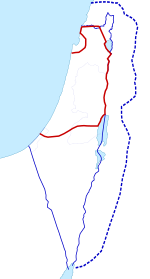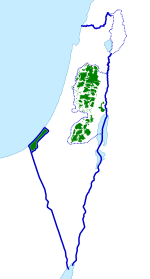History of Palestine
Palestine (Arabic: فلسطين Filasṭīn, Falasṭīn, Filisṭīn; Greek: Παλαιστίνη, Palaistinē; Latin: Palaestina; Hebrew: פלשתינה Palestina) is a geographic region in Western Asia between the Mediterranean Sea and the Jordan River. It is sometimes considered to include adjoining territories. The name was used by Ancient Greek writers, and was later used for the Roman province Syria Palaestina, the Byzantine Palaestina Prima and the Umayyad and Abbasid province of Jund Filastin. The region is also known as the Land of Israel (Hebrew: ארץ־ישראל Eretz-Yisra'el),the Holy Land, the Southern Levant, Cisjordan, and historically has been known by other names including Canaan, Southern Syria and Jerusalem.
Situated at a strategic location between Egypt, Syria and Arabia, and the birthplace of Judaism and Christianity, the region has a long and tumultuous history as a crossroads for religion, culture, commerce, and politics. The region has been controlled by numerous different peoples, including Ancient Egyptians, Canaanites, Israelites, Assyrians, Babylonians, Persians, Ancient Greeks, Romans, Byzantines, the Sunni Arab Caliphates, the Shia Fatimid Caliphate, Crusaders, Ayyubids, Mameluks, Ottomans, the British and modern Israelis and Palestinians.
Boundaries of the region have changed throughout history, and were last defined in modern times by the Franco-British boundary agreement (1920) and the Transjordan memorandum of 16 September 1922, during the mandate period. Today, the region comprises the State of Israel and the State of Palestine.
- Mahmoud Darwish
- Tamim Bargouti
Famous Palestinian Poets (Written in English)
- Rafeef Ziadah (We Teach Life, Sir)
- Susan Abulhawa (Wala!)
- Remi Kanazi
Poetry: How it all started
1. Read a lot of good and high quality poetry
2. Believe you can write good stuff
3. Have the will to do so
4. Scribble your thoughts down. Always
5. Imitate
What is in my poetry?
- Dialouge
- Performance / Drama
- About Palestine
Questions that were asked by some of the students to the Scholar.
1. Who are your favourite poets and why?
Answer : John Donne
2. What was the style of poetry written before the war came to Palestine?
Answer : Personal poetry that was distinticve. It was pretty much the same style before the was began. Poetry became intense after the war broke out in Palestine.






No comments:
Post a Comment